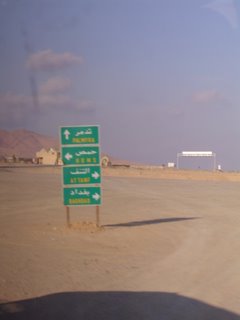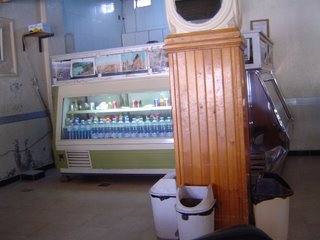



Pictures:
I'm having trouble posting photos for some reason at the moment. In the meantime here's a few:Photo 1: St Georges Bay Sailing Club Beirut, Lebanon which suffered a terrorist bomb blast in February 2005 which took the life of a former Lebanese Prime Minister and seventeen othersPhoto 2: The Temple of Bacchus, Baalbek, LebanonPhoto 3: Signs for Hezbollah in Bekaa Valley, Lebanon It was about 8 pm and absolutely poured with rain when I arrived in Beirut. Through that night a mighty and very loud thunderstorm went on for what seemed like hours.
I went for a cab ride around town to orientate myself and have a look at the city at night.
Beirut is on the Mediterranan coast and there are some lovely view points around the city, particularly an area called "The Pigeon Rocks". This area, to me, felt very much like Eastern Sydney coastal areas.
The "Downtown" area was obliterated in the 70s. There's been civil war between Muslims and Christians, there's been war with the Israelis and more recently problems with Syria leading to terrorist attacks. Part of the shopping area has been rebuilt and feels a little weird. It's flawless, built in sympathy with surrounding buildings in this honey coloured stone (one book describes it as Disney like, which I felt was a fair description), though it was like a ghost town when I was there.
The cab driver was going to drop me at a restaurant with a view for late dinner and I asked him to take me to a cafe that he would eat at.
It looked promising as the cafe was up a back street, clean as a really clean whistle and the few men in there were watching tv with their food etc.
The food was brilliant. I'm not sure what the best part was; Great tasting grilled meat, awesome meze dips, fresh salads, soft warm bread though I fear that perhaps the real reason I felt like a king when I was eating was that I was served the first beer that I'd had on the trip.
No, wait, I tell a lie. Two men in a shop in Petra happily sold me what they thought was the best beer in the world. I was ecstatic to find beer being sold in a corner style store. When I got to my room and opened them, I found out pretty quickly that it was (Laziza) non alcoholic beer. I had bought three bottles and tipped two and three quarters down the sink.
So not only was I served a beer, it was actually an ice cold, alcoholic beer in a chilled glass; it went down a treat.
Beirut is known for it's excellent nightclubs with great live music.
I felt pretty exhausted, having started the day in the desert way back when and I would have probably gone out if I was with someone half keen to go, but instead watched half of a early 70s Egyptian movie featuring many beautiful, leggy women. Strangely, the plot would always work so there was a focus on their bare legs). I'm not complaining, though it was weird.
Thinking about it now, I guess Benny Hill reruns would seem a trifle odd to a newly arrived foreign initiate.
Next day, just another quick look around the town in daylight.
There's a lot of very expensive new developments built all over the city, though they will be next door to most run down looking places.
Buildings are scarred from bullets and war blasts. I wouldn't pretend to know what sort of horrible things the People of Beirut had gone through in very recent past. I cannot imagine the mind set of someone who has lived through seing death, bombs, shootings in their own town and then staying there and getting on with it. The few people I met were very nice to me and it didn't seem very polite to discuss their opinions on things at length. The taxi driver, with whom I spent about an hour and a half just wanted to focus on the rebuilding of the city.
I got a bus stop and began a three part journey to Baalbek, in the Bekaa Valley, near the Syrian Border.
The bus ride is a story in itself which I won't go into now, though at one stage, I felt I was being transported by the Beverly Hillbillies of the Bekaa Valley of Lebanon.
My main reason to go was to see the ruins of Baalbek on the way to Damascus.
A UNESCO site, apparently Baalbek is one of the finest examples of architecture at Imperial Rome's most powerful point.
Baalbeck’s awe-inspiring temples and city ruins are among the largest and finest examples of Roman architecture in the world. Visitors can easily spend several hours, or an entire day, exploring the wonders of this ancient city – from the grandeur of the columned temples to the intricately carved stonework, and the sheer size of the stones used to construct the temples. Like many archaeologists and historians, you will be amazed at the ancient feats of engineering required to build these magnificent stone monuments.From sacredsites.comAs I walked into the site I was accosted by a few people selling coins and the usual guidebooks. One guy, however was imploring I buy one of his t shirts, which featured a shadow of a raised arm holding a huge gun.
Vague, as I am, I said no an walked on into the site. I hired a guide to show me around for an hour. (hiring a guide sounds expensive, though it's excellent value and as you can imagine you get a lot more out of a visit anywhere).
My guide had been working there since 1962. 1962!! He knew it all. He was a nice bloke and he made it all very interesting. The main things that stick in my mind are the mind blowing size of the structures and the stones they moved to put it in place.
In 27 BC, the Roman emperor Augustus supposedly took the unfathomable decision to build in the middle of nowhere the grandest and mightiest temple of antiquity, the Temple of Jupiter, whose platform, and big courtyard are retained by three walls containing twenty-seven limestone blocks, unequaled in size anywhere in the world, as they all weigh in excess of 300 metric tons. Three of the blocks, however, weigh more than 800 tons each. This block trio is world-renowned as the "Trilithon".People that should know don't know how these foundation blocks were transported. It's a mystery to rival the pyramids, apparently.
Snowcapped mountains as a backdrop against the ruins made a beautiful setting.
"Why these stones are such an enigma to contemporary scientists, both engineers and archaeologists alike, is that their method of quarrying, transportation and precision placement is beyond the technological ability of any known ancient or modern builders. "From:http://www.sacredsites.com/middle_east/lebanon/baalbek.htm. It has good pictures if you want more info on Baalbek.
My Guide book mentioned a kidnapping and shooting within Baalbek in the seventies by the Hezbollah party. I mentioned this to my guide an he said he knew nothing of it, followed by silence. I didn't persue the point. Though the penny was starting to drop for me about the t shirt and posters I had seen in the town:
From Frontline:"Posters of Hezbollah "martyrs," or suicide bombers, line the streets of the city. A souvenir store sells videos of Hezbollah guerrillas attacking Israeli soldiers, alongside shelves of Hezbollah hats and postcards. They even market a Hezbollah scent called "perfume of the martyrs." "I asked the guide (I've forgotten his name, unfortunately) where is a cheap place for good Lebanese food and he took me fifty metres to his mate's cafe. I was warmly welcomed into a small, bare cafe that made the King of Yeeros' Wickham Castle look like a Mc Donalds.
They wanted to chat and fed me good microwavable local pastries. I noticed a few bottles of wine. I was aware that Lebanese wine is very famous and recently had read the best wines of Lebanon come from the Bekaa Valley. They served me excellent wine and coffee which doubled my heart rate.
It felt real good being there.
I caught a bus to a town called Chtaura and then a taxi in the form of a huge American gas guzzling Dodge, to cross the border and go to Damascus, Syria.















